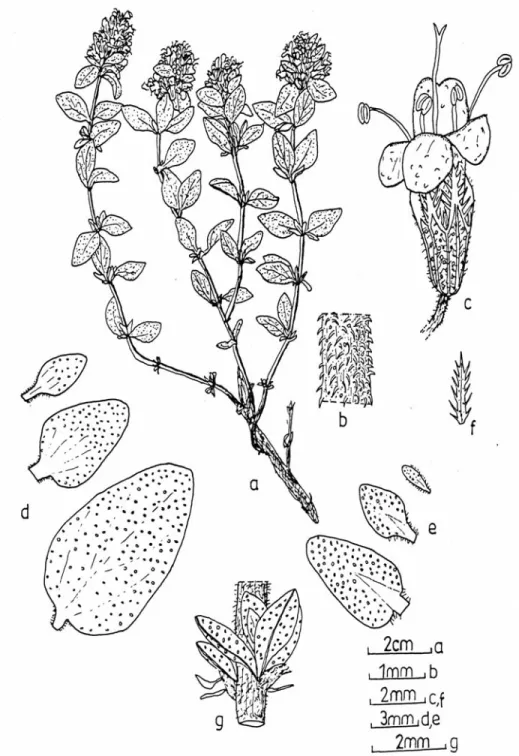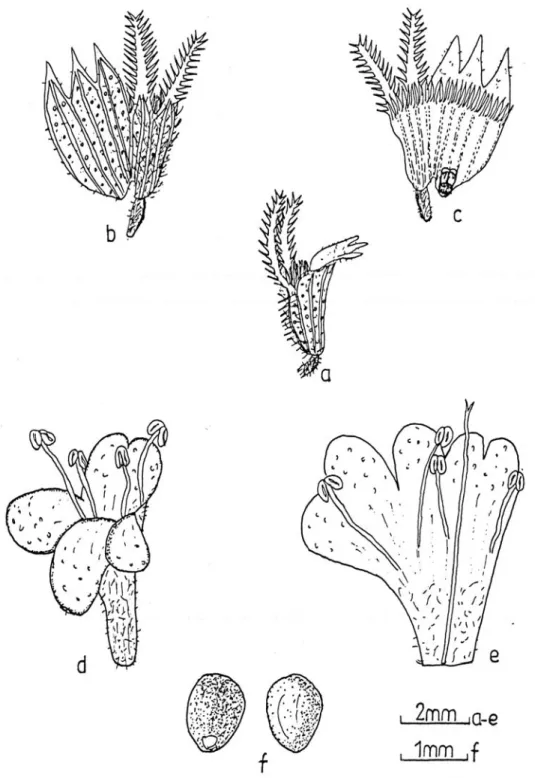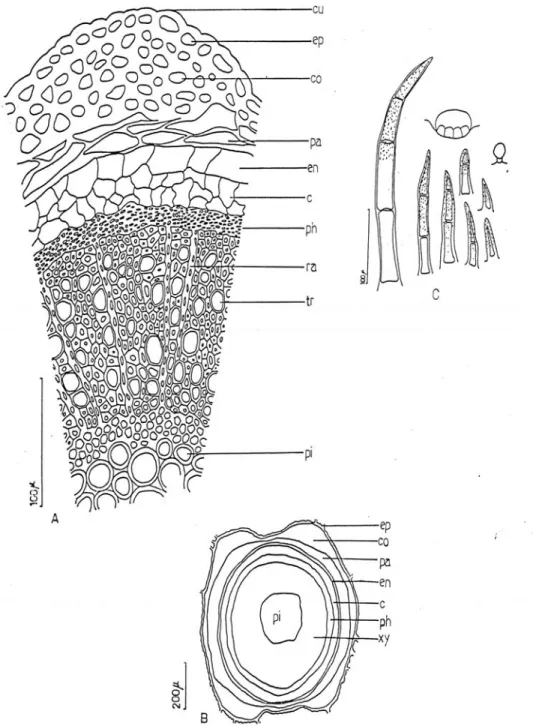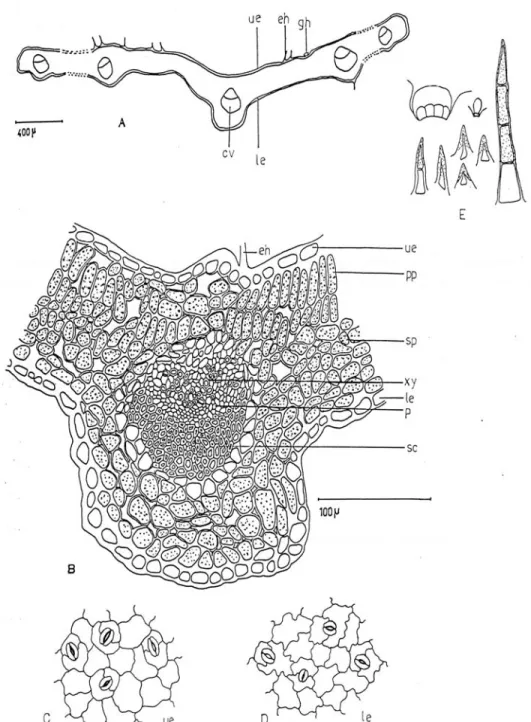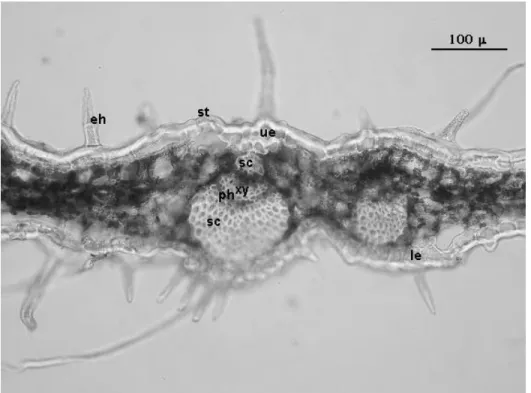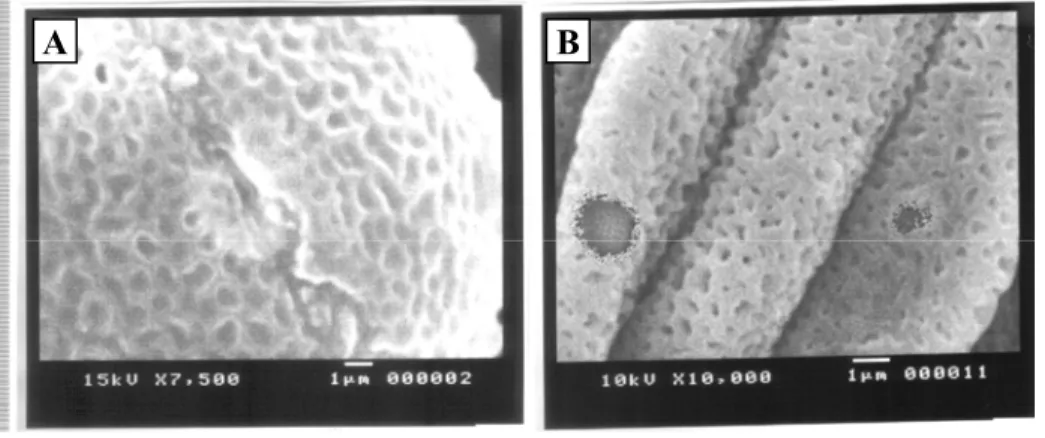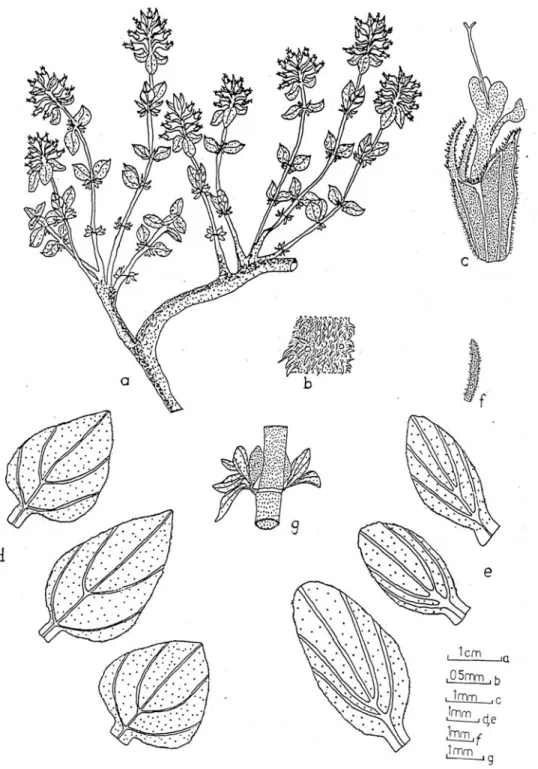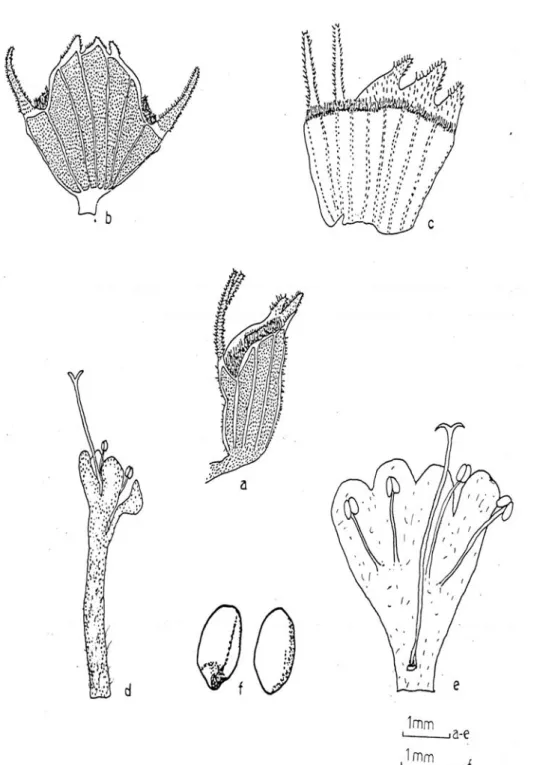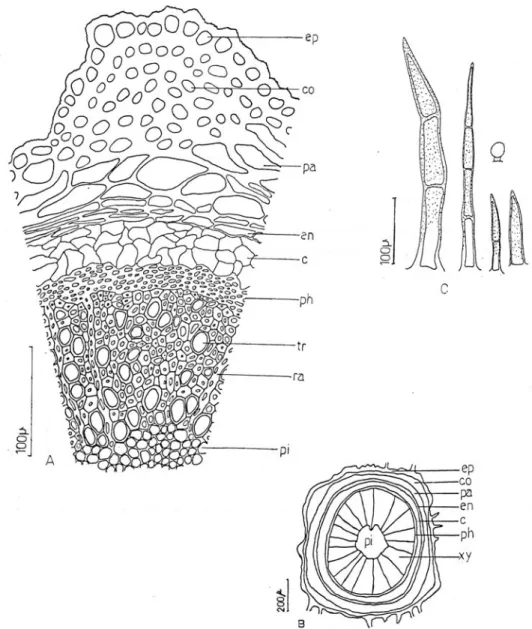Pak. J. Bot., 37(3): 531-549, 2005.
COMPARATIVE MORPHOLOGICAL ANATOMICAL AND
PALYNOLOGICAL STUDIES ON THYMUS MIGRICUS KLOKOV
& DES.-SHOST AND T. FEDTSCHENKOI RONNIGER VAR.
HANDELII (RONNIGER) JALAS GROWN IN EAST ANATOLIA
FATİH SATIL1*, AYLA KAYA2, ADEM BIÇAKCI3,
SİBEL ÖZATLI1 AND GÜLENDAM TÜMEN1
1*Department of Biology, Faculty of Science and Letters,Balıkesir University, 10100 Balıkesir, Turkey, 2Pharmaceutical Botany, Faculty of Pharmacy, Anadolu
University, 26470 Eskişehir, Turkey, 3Department of Biology, Faculty of Science and Letters, Uludağ University, Bursa, Turkey
Abstract
Thymus migricus Klokov & Des.-Shost., and T. fedtschenkoi Ronniger var. handelii
(Ronniger) Jalas are growing in Eastern Anatolia. Thymus fedtschenkoi var. handelii is an endemic species as the other is Iran-Turan element. Both the species have similar morphological, anatomical and palynological features. However, some differences have been determined in between species.
T. migricus is similar to T. fedtschenkoi var. handelii but bigger in all its parts. Their leaves
dimensions, lateral veins, hairs of outer calyx surface and nutlets shape are morphological different. Exine sculpturing is microreticulate in T. migricus while it is suprareticulate in T. fedtschenkoi.var.
handelii in pollen morphology.
Indroduction
The genus Thymus (Lamiaceae) is distributed in an area stretching from Mediterranean region to Europe, West Asia, North Africa, Canarian Island and North-West of Grönland Island (Hegi, 1964). In Turkey it is represented by 39 species with 64 taxa, 24 of which are endemic (Davis, 1982; Başer et al., 1995). In Turkey, members of this genus are called ‘kekik’ or ‘taş kekik’ when dried herbal parts are used as herbal tea, condiments and folk medicine (Tümen et al., 1995). Origanum, Thymbra, Coridothymus and Satureja are export commodities under the name ‘kekik’. Thymus spp., however, are also a source of essential oil and they are mainly used in herbal tea in the areas where they grow (Başer et al., 2002).
The first detailed information on species of Thymus growing in Turkey was given in
Flora Orientalis by Boissier (1879). Hayek (1931) provided some further information on Thymus species collected from Turkey. Later, Thymus species growing in Turkey was
described in the Flora of Turkey in which the author descibed 37 species (Jalas, 1980; 1982). The number of Thymus species in Turkey has risen to 39 by a recent investigation in Turkey (Başer et al., 1995).
There have been very few studies on the morphology and anatomy of Thymus species in Turkey (Sezik & Saraçoğlu, 1988; Kesercioğlu et al., 1990; Tavukçuoğlu et
al., 1996, Alan, 1997; Özatlı & Tümen, 2000; Başer et al., 2000; Aytaş, 2003). There are
no studies on the pollen morphology of Thymus fedtschenkoi and Thymus migricus. Nabli (1976), Moore et al., (1991) and Şakıyan (1998) have given information on the pollen of the Thymus genus. In the present study both of the species has been compared by their morphological-anatomical characteristics and palynological features.
FATİH SATIL ET AL.,
532
Materials and Methods
Information about the plant material is given in Table 1. Voucher specimens are kept at the Herbarium of the Faculty of Pharmacy of Anadolu University in Eskişehir, Turkey (ESSE).
Table 1. Collection site, dates, and ESSE number of Thymus spp. studied.
Thymus spp. Collection data ESSE No
T. migricus B9 VAN: Erçiş, Sabanbüken village, 2000 m,
28.06.1996, G.Kıvrak, G.Tümen.
B9 VAN: Erçiş, Yünören village, 1950 m,
25.06.1996, G.Tümen.
ESSE 12272 ESSE 12273
T. fedtschenkoi var. handelii B9 BİTLİS: Adilcevaz to Ahlat, 15 km from
Adilcevaz, 10.07.1998, S. Özatlı ESSE 13029
Morphological features were determined on living and herbarium materials. Approximately 30 specimens were used to determine the morphological characteristics under Wild M5 stereomicroscope with drawing tube.
Samples were fixed in 70 % alcohol for anatomical studies. Transverse sections and surface preparations of root and leaves were made manually. The Sartur reactive (Baytop, 1972) was applied to the sections for a better understanding of some anatomical structures. Olympus BX50 binocular microscope with drawing tube were used in anatomical studies. Photographs were taken by Olympus Camedia.
Polliniferous material was taken from the herbarium of the Balıkesir University. Pollen preparations of the species were made by the method of Wodehouse (1935). The LM studies were made using a Zeiss microscope with an appochromatic oil-immersion objective (x100) and periplan eye pieces (x10). Measurements are based on 20 or more pollen grains for two taxa. The photomicrographs were taken with the same microscope using its photographics outfits.
For scanning electron microscopy (SEM), the pollen grains were transferred directly to double-sided tape affixed srubs, and vacuum-coated with gold. Photomicrograps were taken partly with a JSM-5400 JEOL scanning electron microscopy.
The terminology in this paper corresponds to that used by Faegri & Iversen (1975). Results
The following description is based on our own observations and that of in the Flora of Turkey (Davis et al., 1982):
Thymus migricus Klokov & Des.-Shost.
Morphological studies
Perennial herbs, basal parts woody, suberect, much branching, Flowering stems 4-13 cm, ± slender, often branched apically, hairy all round. Leaves 9-12 x 4-7.5 mm, triangular-ovate to ovate-lanceolate, truncate to rounded-cuneate and sparsely ciliate or not at base, ± obtuse to subacute at apex, often ± carnose, both surfaces covered sparsely eglandular hairs, oil dots numerous, reddish; veins usually weakly prominent or not, lateral veins 2(-3) pairs, petiole 1-2 (-2.5) mm. Inflorescence 0.8-2.5 cm, 2-14-flowered,
STUDIES ON THYMUS MIGRICUS AND T. FEDTSCHENKOI 533
loosely capitate, lowest verticillasters often ± remote, pedunculate 2.5-3.2 mm. Bracts leaf-like, green, 1.2-5.5 x 0.5-2.5 mm. Bracteoles 1-2 x 0.4-0.5 mm, lanceolate, margine ciliate (Fig. 1). Calyx 3.2-5 mm, clearly 10-veined, campanulate, bilabiate, upper lip clearly wider than tube, upper teeth 0.4-1(-1.5) mm, broadly triangular, scabrous, not ciliate, lower teeth 2-2.5 mm, lanceolate, narrowly triangular, ciliate, outer long-scabrid-hirsute (especially in below the lower teeth), dense glandular, long-bearded in throat, Corolla 5-7.5 mm, white, purplish-pink in lips, exserted calyx, bilabiate, upper lip emarginate, lower lip 3-lobed, outer surface pubescent and glands. Stamens 4, didinamous, filaments white 2-4 mm, anthers purplish-pink, 0.2-0.5 mm, dorsifix, ovary 4-lobed, oblong, style white, 5.5-7 mm, stigma purple-pink, bifid. Nutlets dark brown, 0.8-1 x 0.6-0.9 mm, broadly ovate-rotund (Fig. 2).
Flowering period: June-July, Habitat: Dry mountain slopes, 800-2500 m Distribition in Turkey: East Anatolia (Muş, Van, Bitlis, Ağrı, Kars) Anatomical studies
Stem: The epidermis is composed of a single layer with oval cells. Upper and lower walls are thicker than lower and lateral walls. Eglandular hairs are more common than glandular hairs. Covering trichomes are unicellular or multicellular (up to 4) and are also covered with a thin cuticle. 1-2-celled hairs are more frequent. There are two types of glandular hairs: Stalked glandular trichome with unicellular head type and Labiatae type. The collenchyma tissue which is irregular cells and located immediately under the epidermis is 3-5-layered on the corners and 1-2-layered in between the corners. They are irregular and fairly thick walled. Parenchyma tissue is 1-2-layered and usually squashed. Endodermis is single layered. There is sometimes 2-3-layered cork tissue below endodermis. Pericycle is indistinguishable. Phloem is 3-5-layered and consists of irregular and squashed cells. Cambium is also not observed. Xylem comprises trachea and tracheids. Trachea are orbicular or ovoid while tracheids are polyhedral. Rays are usually uniseriate. Pith consists of large orbicular or polyhedral parenchymatous cells. The cells of near the centre region are squashed (Fig. 3, 4).
Leaves: The epidermis is composed of a single layer cells and rectangular or oval cells. Upper epidermis is larger than lower and covered with a thick undulate cuticle. Upper walls are thicker than lower and lateral walls. There are glandular and eglandular hairs on the surfaces of both epidermis. Covering trichomes are 1-4-celled and are tooth-shaped. 1-2 celled hairs are more frequent. Two types of glandular hairs are encountered: Stalked glandular trichome with unicellular head type and Labiatae type. Stalked glandular trichome with unicellular head type is rare and embedded in the surfaces of epidermis. Galndular hairs are reddish. Stomata type is diacytic (Metcalfe & Chalk, 1950) and occurs on the surfaces of both epidermis being more abundant on the lower surface. They are located on the same level with epidermal cells or slightly higher. Leaf is isolateral. Mesophyll occurs 1-2 seriate palisade tissue and 2-5-seriate spongy parenchyma. Vascular bundles is less-developed. Vascular bundles occur in a narrow area and are surrounded by bundle sheath. The xylem faces towards the upper surface while phloem faces the lower epidermis. The phloem tissue are surrounded by thick sclerenchymatous tissue towards the lower epidermis. There are parenchymatous cells under the upper and lower epidermis in the midrib region (Fig. 5, 6).
FATİH SATIL ET AL.,
534
Fig. 1. Thymus migricus (ESSE 12272): a-Habit, b-Stem, c- Flower, d-Leaf, e-Bracte, f-Bracteol, g-Axillary fascicles.
STUDIES ON THYMUS MIGRICUS AND T. FEDTSCHENKOI 535
FATİH SATIL ET AL.,
536
Fig. 3. Thymus migricus (ESSE 12272): A-B) Cross-section of stem, C) Hair types in stem, cu-Cuticula, ep-Epidermis, co-Collenchyma, pa-Parenchyma, en-Endodermis, c-Cork, ph-Phloem, ra-Rays, tr-Trache, xy-Xylem, pi-Pith.
STUDIES ON THYMUS MIGRICUS AND T. FEDTSCHENKOI 537
Fig. 4. Thymus migricus (ESSE 12272): Cross-section of stem, eh-Eglandular hair, cu-Cuticula, ep-Epidermis, c-Collenchyma, pa-Parenchyma, en-Endodermis, co-Cork, ph-Phloem, xy-Xylem.
Description of pollen grains in Thymus migricus
Pollen grains isopolar, hexacolpate, suboblate (P/E 0.84), polar axis 27.73 µm, equatorial axis 32.93 µm. Amb hexagonal (Fig. 7). Exine 1.8 µm thick in equator, 2.0 µm thick at poles. Intine 0.75 µm. Colpi with pointed end long.Clg 19.6 µm, Clt 3.6 µm. Distance between colpi ends 5.6 µm. Apocolpium small. Colpus membrane is granulate.
Exine sculpturing microreticulate in SEM (Fig. 8).
Thymus fedtschenkoi var. handelii (Ronniger) Jalas
Morphological studies
Perennial herbs, basal parts woody, subshrub, much branching. Flowering stems 2-11 cm, rotunded, densely patent hirsute all round. Leaves 2.5-5 x 2-3.5 mm, petiole 1-1.5 mm, ovate to triangular-ovate, rounded-obtuse at base, acute at apex with usually 2 pairs of prominent lateral veins joining to form a marginal thickening, top surfaces covered densely eglandular hairs, both surfaces covered densely with Labiatae type glandular
FATİH SATIL ET AL.,
538
Fig. 5. Thymus migricus (ESSE 12272): A-B) Cross-section of lead, C-D) The stomata from upper and lower epidermis of leaf, E) Hair types in lead, ue-Upper epidermis, le-Lower epidermis, eh-Eglandular hair, gh-Glandular hair, cv-Central vessel, pp-Palisade parenchyma, sp-Spongy parenchyma, xy-Xylem, p-Phloem, sc-sclerenchyma.
STUDIES ON THYMUS MIGRICUS AND T. FEDTSCHENKOI 539
Fig. 6. Thymus migricus (ESSE 12272): Cross-section of leaf, eh-Eglandular hair, st-Stomata, ue-Upper epidermis, le-Lower epidermis, sc-sclerenchyma, xy-Xylem, ph-Phloem.
Fig. 7. A-B) Thymus fedtschenkoi var. handelii; C-D) Thymus migricus: A, C) Equatorial view; B, D) Polar view
A
B
D
C
FATİH SATIL ET AL.,
540
hair, oil dots reddish. Inflorescence 0.5-1.5 cm, verticillasters, with few-flowered Bracts, 2-3 x 1.5-2 mm, ovate-lanceolate, obtuse at apex and base. Bracteoles lanceolate, 0.5-1 x 0.4-0.7 mm, ciliate, pedicels 1-2 mm (Fig. 9). Calyx 3-4 mm, tubulate-campanulate, tube 1.5-2 mm, clearly 10-veined, bilabiate, upper teeth 0.5-1 mm, ovate-triangular,lower teeth 1-1.5 mm, linear-lanceolate, ciliate, upper teeth equalling lower or somewhat shorter, outer scabrid-hirsute, dense glandular, bearded in throat. Corolla 5-6 mm, white or pale purple-lilac, tubulate-campanulate, bilabiate, exserted from calyx, upper lip emarginate, lower lip 3-lobed, outer surface pubescent and glands. Stamens 4, didynamous, filaments white 2-3.5 mm, anthers pale brown or dark, 0.4-0.5 mm, dorsifix, ovary 4-lobed, oblong, style 6-7 mm, exserted from tube, stigma decurrent. Nutlets brown, 0.8-1 x 0.5-0.8 mm, narrowly oblong (Fig. 10).
Flowering period: May-July, Habitat: Stony mountain slopes, 1740-3100 m. Distribition in Turkey: Endemic, East Anatolia (Van, Bitlis, Ağrı)
Anatomical studies
Stem: Obviously square. The epidermis is composed of a single layer with rounded oval or square cells. Upper wall is thicker than lower and lateral walls are also covered with a thick cuticle. Covering trichomes are 1-4-celled. Multicellular hairs are more frequent. Glandular hairs are stalked glandular trichome with unicellular head type and Labiatae type. The collenchyma tissue is 3-5-layered on the corners and 1-2-layered in between the corners and they are irregular rounded and slightly pressed which are located immediately under the epidermis. Parenchyma tissue is 2-4-layered and usually squashed. Single layered endodermis consists of rectangular cells and it sometimes is squashed. There is a 3-5-layered cork tissue below endodermis. Pericycle is not observed. Phloem is 3-5-layered and consists of irregular and squashed cells. Cambium is also not distinguished. Xylem forming a continuous cylinder. Trachea are orbicular or ovoid while tracheids are polyhedral. Rays are uniseriate. Pith consists of large orbicular or polyhedral parenchymatous cells. Those cells underlying the xylem are narrower and thick-walled (Fig. 11, 12).
Leaves: The epidermis is composed of a single layer rectangular cells. Upper epidermis is larger than lower epidermis and covered with a thin cuticle. Also, lower epidermis is covered with a undulate cuticle. Covering trichomes are like the stem. There are glandular and eglandular hairs on the surfaces of both epidermis. Trichomes are 1-5-celled and multicellular hairs are more common and covered with a thin cuticle. Two types of glandular hairs are encountered: Stalked glandular trichome with unicellular head type and Labiatae type. Stalked glandular trichome with unicellular head is rare. Glands are embedded in the surfaces of epidermis. Stomata type is diacytic (Metcalfe & Chalk, 1950) and occurs on the surfaces of both epidermis being more abundant on the lower surface. They are located on the same level with epidermal cells or slightly higher. Leaf is isolateral. Mesophyll occurs 1-2-seriate palisade tissue which has densely chloroplast and ergastic subtances and 2-5-seriate spongy parenchyma with dense starch. They are ovoid-shaped. Vascular bundles is less-developed. Sclerenchymatic tissue is well developed in vascular bundles which are surrounded by bundle sheath. Xylem faces towards the upper surface while phloem faces the lower epidermis. Phloem is 3-5 layered and located on sclerenchymatic tissue. There are 1-2-seriate palisade tissue under the upper epidermis in the midrib region (Fig. 13, 14).
STUDIES ON THYMUS MIGRICUS AND T. FEDTSCHENKOI 541
Fig. 8. (SEM) Detail of pollen wall surface
Thymus fedtschenkoi var. handelii (A); Thymus migricus (B)
Description of pollen grains in Thymus fedtschenkoi var. handelii
Pollen grains isopolar, hexacolpate, suboblate (P/E 0.79), polar axis (P) 27.2 µm, equatorial axis (E) 34.16 µm. Amb hexagonal (Fig. 7). Exine 1.8 µm thick in equator, 2.1 µm thick at poles. Intine 0.8 µm. Colpi with pointed end long.Clg 20.0 µm, Clt 4.75 µm. Distance between colpi ends 5.12 µm. Apocolpium small. Colpus membrane is granulate. Exine sculpturing suprareticulate in SEM. Lumina diameter 1-1,5 μm. The numbers of perforation are 1-3 in the each lumina (Fig. 8).
Discussion
Morphological, anatomical and palynological characteristics were comparatively investigated in T. fedtschenkoi var. handelii and T. migricus growing in Eastern Anatolia.
T. fedtschenkoi var. handelii is an endemic taxon. Previous descriptions of the species
were examined and some descriptions are supplemented and corrected in the light of the new materials and observation of plants in their habitats. These species are similar in morphology except for their leaves dimensions, lateral veins, hairs of outer calyx surface and.nutlets shaped. The leaves of T. fedtschenkoi var. handelii are 2.5-5 x 2-3.5 mm as they are 9-12 x 4-7.5 mm in T. migricus. However, lateral veins of leaves evanescent in
T. migricus while lateral veins of leaves joining to form a marginal thickeing in T. fedtschenkoi var. handelii (Figs. 1-9-d ). The outer calyx surface in T. migricus is
especially long-scabrid-hirsute in below the lower teeth according to T. fedtschenkoi var.
handelii (Figs. 2-10-a-c). The nutlets-shaped are broadly ovate-rotund in T. migricus as
they are oblong T. fedtschenkoi var. handelii. (Figs. 2-10- f)
The morphological characters of T. fedtschenkoi var. handelii, T. migricus and Flora of Turkey are compared (Table 2). Fowering stems of T. fedtschenkoi var. handelii in our samples are longer than flora of Turkey. Furthermore, flowering stems are of different length (2-4 cm in T. fedtschenkoi var. handeliiand 5-10 (15) cm inT. migricus) according
to flora but, they are almost equal in length according to our observations (2-11 cm in T.
fedtschenkoi var. handeliiand 4-13 cm inT. migricus) In addition, filaments, style and
nutlets features are given for the first time in this study. All other morphological parts are similar to the Flora of Turkey. As a result, T. migricus is similar to T. fedtschenkoi var.
handelii but bigger in all its parts.
FATİH SATIL ET AL.,
STUDIES ON THYMUS MIGRICUS AND T. FEDTSCHENKOI 543
Fig. 9. Thymus fedschenkoi var. handelii (ESSE 13029): a-Habit, b-Stem, c- Flower, d-Leaf, e-Bracte, f-Bracteol, g-Axillary fascicles.
FATİH SATIL ET AL.,
544
STUDIES ON THYMUS MIGRICUS AND T. FEDTSCHENKOI 545
Fig. 11. Thymus fedschenkoi var. handelii (ESSE 13029): A-B) Cross-section of stem, C) Hair types in stem, ep-Epidermis, co-Collenchyma, pa-Parenchyma, en-Endodermis, c-Cork, ph-Phloem, tr-Trache, xy-Xylem, ra-Rays, pi-Pith.
The results obtained from anatomical investigation carried out on representative taxa were generally similar. No important differences observed in leaf and stem anatomical features of T. fedtschenkoi var. handelii and T. migricus. However, collenchyma tissue is large in stem of T. fedtschenkoi var. handelii, while it is narrow in that of T. migricus Also, eglandular hair is long in stem and leaf of T. fedtschenkoi var. handeli, while it is small in that of T. migricus (Table 3).
FATİH SATIL ET AL.,
546
Table 3. The comparison of Thymus fedtschenkoi var. handelii and
Thymus migricus. Anatomical features.
Thymus fedtschenkoi var. handelii Thymus migricus Stem
Cortex large narrow
Collenchyma large 1-2-layered in between the corner
3-5-layered on the corner
narrow
1-2-layered in between the corner 3-5-layered on the corner
Parenchyma 2-4-layered 1-2 -layered
Cork 3-5-layered 2-3-layered
Rays Partly rare densely
Eglandular hairs
Glandular hairs Labiatae type and stalked glandular 1-4celled, usually 2-3-celled, long trichome with unicellular head
1-4-celled, usually 1-2 celled, small Labiatae type and stalked glandular
trichome with unicellular head
Leaf
Eglandular hairs Glandular hair
1-5-celled, usually 1-2-celled, long Labiatae type and stalked glandular trichome with unicellular head
1-4-celled, usually 1-2-celled, small Labiatae type and stalked glandular
trichome with unicellular head
Fig. 12. Thymus fedschenkoi var. handelii (ESSE 13029): Cross-section of stem, eh-Eglandular hair, cu-Cuticula, ep-Epidermis, c-Collenchyma, pa-Parenchyma, en-Endodermis, co-Cork, ph-Phloem, xy-Xylem, pi-Pith
STUDIES ON THYMUS MIGRICUS AND T. FEDTSCHENKOI 547
Fig. 13. Thymus fedschenkoi var. handelii (ESSE 13029): A-B) Cross-section of leaf, C-D) The stomata from upper and lower epidermis of leaf, E) Hair types in leaf; Upper epidermis, ue-Upper epidermis, le-Lower epidermis, cv-Cenral vessel, pp-Palisade parenchyma, sp-Spongy parenchyma, st-Stomata, xy-Xylem, ph-Phloem, sc-sclerenchyma.
The essential oil contents of the both species were analysed by Başer et al., (2002).
T. migricus is characterized by high concentrations of thymol (38%-44 %) and carvacrol
(36%) in its oil. Although T. fedtschenkoi var. handelii was studied, a clear distinction could be made due to the presence of a high percentage of linalool (12.9%) and low amounts of phenolic monoterpenes in its oil. Though both the species are similar morphologically but they have different components in essential oils chemically.
FATİH SATIL ET AL.,
548
Fig. 14. Thymus fedschenkoi var. handelii (ESSE 13029): Cross-section of leaf, eh- Eglandular hair, gh-Glandular hair, st-Stomata, ue-Upper epidermis, le-Lower epidermis, pp-Palisade parenchyma, sp-Spongy parenchyma
Thymus is a taxon which show very similar palynological features by light
microscopy. Pollen grains isopolar, hexacolpate, suboblate, oblate-spheroidal and prolate-spheroidal. Amb circular or hexagonal (Şakıyan, 1998).
T. fedtschenkoi var. handelii and T.migricus have been examined palynologically for
the first time. Pollen morphology of two species are similar to each other. Light microscopical observations of the present study reveal that pollen grains of T.
fedtschenkoi var. handelii and T. migricus are isopolar, hexacolpate, suboblate, amb
hexagonal. Exine thicker at the poles than equator in two species. Exine sculpturing reticulate that was observed in pollen grains of both the species when light microscope but was different in the studies with SEM. Exine sculpturing is microreticulate in
T.migricus, it is suprareticulate in T.fedtschenkoi var. handelii
Acknowledgement
We would like to thank Prof. Dr. Hayri Duman of Gazi University, Faculty of Science and Letters, Biology Department, Ankara, Turkey for checking the specimens.
STUDIES ON THYMUS MIGRICUS AND T. FEDTSCHENKOI 549
References
Alan, S. 1997. Eskişehir Çevresi Thymus L. Türleri üzerinde Morfolojik ve Anatomik Araştırmalar, Anadolu Üniversitesi, Sağlık Bilimleri Enstitüsü, Yüksek Lisans Tezi, Eskişehir.
Aytaş, T., 2003. Morphological and anatomical studies on some species of Thymus L. (Labiatae) distributed in Karadeniz region. Ot Sistematik Botanik Degisi, 10(1): 31-56.
Başer, K.H.C., M. Vural, G. Tümen, H. Akyalçın and F. Satıl. 1995. Two new taxa for flora of Turkey. Tr. J. of Botany, 19: 491-492.
Başer, K.H.C., A. Kaya, F. Satıl and G. Tümen. 2000. Thymus aznavourii Velen (Labiatae) Üzerinde Morfolojik ve Anatomik Çalışmalar. Ot Sistematik Botanik Dergisi, 7(1): 95-105. Başer, K.H.C., B. Demirci, N. Kırımer, F. Satıl and G. Tümen. 2002. The Essential oils of Thymus
migricus and T. fedtshekoi var. handelii from Turkey. Flavour and Fragrance J., 17: 41-45.
Baytop, A. 1972. Bitkisel Drogların Anatomik Yapısı. Ist. Üniv. Ecz. Fak. Yay. No. 829. (4. baskı). Boissier, E. 1879. Thymus L. in Flora Orientalis, Genevrae et Basileae, IV., p. 554.
Davis, P.H. 1982. Flora of Turkey and the East Aegean Island. Vol. 7. Edinburgh University Press: Edinburgh. 349–382.
Faegri, K. and J. Iversen. 1975. Textbook of pollen analysis, Hafner Press, New York. Hegi, G. 1964. IIIustrierte Flora Von Mittel Europaea, V. Band, IV. Teil,.Münih.
Hayek, A. 1927-1931. Prodromus Florae Penunsulae Balcanicae. Verlag des Repertoriums, 2. Band. Dahm bei Berlin, Berlin.
Jalas, J. 1980. Turkish taxa of Thymus (Labiatae) desuribed as new or revised. Ann. Bot. Fennici, 17: 315-324.
Jalas, J. 1982. Thymus, Flora of Turkey and East Aegean Island, (Ed.): P.H. Davis, Vol. 7, Edinburgh Univ. Press., Edinburgh.
Kesercioğlu, T., T. Tung and M. Nakipoğlu. 1990. Batı Anadolu’nun Endemik Türleri Üzerine Araştırmalar, I Thymus zygioides Griseb. var. Iycaonicus (Celak.) Ronniger. (Yer Kekiği) Üzerine Morfolojik Anatomik ve Sitolojik Araştırmalar, Ormancılık Araş. Enst., Yay. No: 71.
Dergi Serisi, 36(1): 75-90.
Metcalfe, C.R. and L. Chalk. 1950. Anatomy of the Dicotyledons, 2 vol. Clarendon Press. Oxford. Moore, P.D., J.A. Webb and M.E. Collinson. 1991. Pollen analysis. Blackwell Scientific
Publications, Oxford.
Nabli, M.A. 1976. Etude ulstrastructurale comparee de I'exine chez quelques genres de Labiatae.
The evolzetionary significance of the exine. (Ed.) I.K. Ferguson and J. Muller. Academic
Press, Linnean Society of London.
Özatlı, S. and G. Tümen. 2000. Bitlis Yöresinde Yetişen Endemik Thymus fedtschenkoi Ronniger var. handelii (Ronniger) Jalas Üzerinde Morfolojik, Anatomik Çalışmalar. XV. Ulusal Biyoloji
Kongresi, Ankara.
Sezik, E. and İ. Saraçoğlu. 1988. Türkiye’de Halk İlacı ve Çay Olarak Kullanılan Bitkiler Üzerinde Morfolojik ve Anatomik Araştırmalar. V. Thymus eigii (M. Zohary et P.H. Davis) Jalas, Doğa
Tıp. ve Ecz. D., 12(1): 32-37.
Şakıyan, N. 1998. İç Anadolu Bölgesi Thymus L. (Labiatae) polenlerinin morfolojik araştırılması. AÜ Fen Bilimleri Enstitüsü, Doktora Tezi, Ankara.
Tavukçuoğlu, S., G. Kaynak and O. Tuyji. 1996. Uludağ’da Yayılışı Olan Thymus L. Türleri Üzerinde Morfolojik ve Anatomik Araştırmalar, Tr. J. of .Botany, 20: 59-71.
Tümen, G., N. Kirimer and K.H.C. Başer. 1995. Composition of the essential oil of Thymus species growing in Turkey. Khim. Prir. Soedin, 1: 55–60.
Wodehouse, R.P. 1935. Pollen grains. Mc Graw Hill. Press, New York. (Recieved for publication 14 July 2004)
